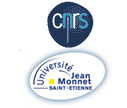Matrix method to predict the spectral reflectance of stratified surfaces including thick layers and thin films
Résumé
The most convenient way to assess the color rendering of a coated, painted, or printed surface in various illumination and observation configurations is predict its spectral, angular reflectance using an optical model. Most of the time, such a surface is a stack of layers having different scattering properties and different refractive indices. A general model applicable to the widest range of stratified surfaces is therefore appreciable. This is what we propose in this paper by introducing a method based on light transfer matrices: the transfer matrix representing the stratified surface is the product of the transfer matrices representing the different layers and interfaces composing it, each transfer matrix being expressed in terms of light transfers (e.g. diffuse reflectances and transmittances in the case of diffusing layers). This general model, inspired of models used in the domain of thin films, can be used with stacks of diffusing or nonscattering layers for any illumination-observation geometry. It can be seen, in the case of diffusing layers, as an extension of the Saunderson-corrected Kubelka-Munk model and Kubelka's layering model. We illustrate the through an experimental example including a thin coating, a thick glass plate and a diffusing background. 2. Introduction For a long time, the variation of the spectral properties of surfaces and objects by application of coatings has been a wide subject of investigation for physicians who proposed several models based on specific mathematical formalisms according to the type of physical components and the application domain. In the domain of paints, papers, and other diffusing media, a classical approach is to use the Kubelka-Munk system of two coupled differential equations to describe the propagation of diffuse fluxes in the medium [1,2]. The extension of this model by Kubelka to stacks of paint layers is based on geometrical series describing the multiple reflections and transmissions of these diffuse fluxes between the different layers [3,4]. Geometrical series were also used by Saunderson [5] when deriving his correction of the Kubelka-Munk model in order to account for the internal reflections of light between the paint layer and the paint-air interface, by Clapper and Yule [6] in their reflectance model
Domaines
Optique / photonique| Origine | Fichiers produits par l'(les) auteur(s) |
|---|
Loading...


